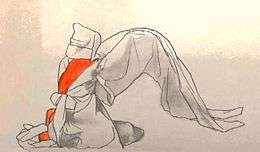Cho Chi-hun
| Cho Chi-hun | |
|---|---|
| Born |
Cho Dong-tak December 3, 1920 Yeongyang |
| Died | May 17, 1968 (aged 47) |
| Language | Korean |
| Nationality | South Korean |
| Ethnicity | Korean |
| Citizenship | South Korean |
| Cho Chi-hun | |
| Hangul | 조지훈 |
|---|---|
| Hanja | 趙芝薰 |
| Revised Romanization | Jo Jihun |
| McCune–Reischauer | Cho Chihun |
Cho Chi-hun (December 3, 1920 – May 17, 1968) was a Korean poet, critic, and activist.[1]
Life
Cho was born on December 3, 1920 in Yeongyang, Gyeongsangbuk-do, during the period of Japanese rule.[2] His birthname was Cho Dong-tak. He graduated from Hyehwa College in 1941 with a degree in Liberal Arts. He taught at Odaesan Buddhist College and in 1946, after Korean Liberation, founded the Association of Young Writers (Cheongnyeon munhakga hyeophoe). Cho also served as president of the Korean Poets Association(Hanguk Siin hyeophoe) and from 1947 served as a professor at Korea University. Cho was also the first head of the Korea University National Culture Research Institute. He died on May 17, 1968.[1]
Cho's birthplace is preserved in Irwol-myeon in Yeongyang. A memorial to him stands on Namsan in Seoul.
Work
The Korea Literature Translation Institute sums up Cho's work in the following way:
- Fine classical beauty of Korea expressed in this work evokes within the reader a feeling of peace and tranquility. "The Grief of Phoenix" (Bonghwangsu), while keenly describing several secrets of the architectural beauty of the palace, contrasts those who held sovereign power in the Joseon era with the intellectuals of the colonial period, exposing the pain and tragic feelings of governed classes. These first poems of Cho Jihun, capturing the lyrical expression of Korea's traditional and national consciousness, are contained in 'The Blue Deer' (Cheongnokjip), written by the poet along with two others, Park Dujin and Park Mokwol.[1]
- Directly after Liberation, contemporary Cho Jihun emphasized that only those who guarded a purely poetic aesthetic could be considered poets, and asserted that the protection of individual freedom and the quest for the liberation of human nature was the essence of poetry. This literary purity and nationalistic fervor are proclaimed in the poet’s patriotic voice in his anthology, 'Standing Before History' (Yeoksa apeseo). The work criticizes, with a lucid historical consciousness, the political corruption and social irrationality engendered by the national division and internal strife of the day. In particular, "Dabuwoneseo" is one of the finest examples of war poetry that keenly depicts the tragic state of internal strife based on a personal experience.[1]
The Nun's Dance
Cho Chi-hun's early love of Korean tradition is expressed in his poem "The Nun's Dance" (승무(僧舞).[3]

얇은 사(紗) 하이얀 고깔은 고이 접어서 나빌레라.
- Folded delicately to shape
- The fine gauze white cowl
- Wavers gently.
파르라니 깎은 머리 박사(薄紗) 고깔에 감추오고,
- The bluish head shaved close
- Is veiled under the tenuous cowl.
두 볼에 흐르는 빛이 정작으로 고와서 서러워라.
- The glow in the cheeks
- Graces her in her sorrow.
빈 대(臺)에 황촉(黃燭)불이 말없이 녹는 밤에 오동(梧桐)잎 잎새마다 달이 지는데,
- The wax candle quietly burns in an empty hall,
- And the moon sinks into every paulownia leaf.
소매는 길어서 하늘은 넓고,
돌아설 듯 날아가며 사뿐히 접어 올린 외씨보선이여.
- Her long sleeves against the vast heaven
- Billow up as if on the wing.
- O how shapely her white socks match her movement!
까만 눈동자 살포시 들어 먼 하늘 한 개 별빛에 모두오고,
- She raises her dark eyes to gaze
- On a star in the far off sky.
복사꽃 고운 뺨에 아롱질 듯 두 방울이야 세사(世事)에 시달려도 번뇌(煩惱)는 별빛이라.
- Her cheeks fair as peach blossoms
- Are stained with a tear-drop or two.
- In the face of worldly cares
- Her suffering shines like a star.
휘어져 감기우고 다시 접어 뻗는 손이 깊은 마음 속 거룩한 합장(合掌)인 양하고,
- Her arms swaying and turning,
- Folding and unfolding, tell
- Of her devout prayer at heart.
이 밤사 귀또리도 지새우는 삼경(三更)인데, 얇은 사(紗) 하이얀 고깔은 고이 접어서 나빌레라.
- When the very crickets cry through the midnight
- The fine gauze white cowl wavers
- Gently, delicately folded into shape.[4]
The origin of the dance antedates the introduction of Buddhism into Korea and expresses the traditional Korean philosophy of the harmony of heaven and earth. Popularly, however, it is taken to represent the inner conflict of an apostate nun, or the sorrow of a beautiful woman's renunciation of her erotic past, which the poet references. The dancer Han Yong-Suk used to claim that it was her performance which inspired the poet, after he had watched it many times.[5]
Works in Translation
- Brother Enemy (한국전쟁 시선집)
Works in Korean (partial)
Criticism
- A Theory on History of Korean Culture
Anthologies
- The Blue Deer
- Short Lines over Grasses:풀잎 단장(斷章)
- Selected Poems of Cho jihun
- Stand Before History
- Lingering Resonance
- Stylish Antique Costumes:고풍의상(古風依裳)
Essays
- Leaning against the Window
- Poetry and Life
- Theory of Integrity
- Aesthetics of Rocks.
Awards
- Literature Prize of the Free Writers' Association, 1956
See also
References
- 1 2 3 4 ”Cho Jihun" LTI Korea Datasheet available at LTI Korea Library or online at: "Archived copy". Archived from the original on 2013-09-21. Retrieved 2013-09-03.
- ↑ "Naver Search". naver.com. Naver. Retrieved 8 December 2013.
- ↑ A performance of the dance on YouTube
- ↑ Jaihiun Kim, Modern Korean Poetry, Fremont CA 1994, p.138
- ↑ Lee-Kyong-hee, “Epitome of Korean Folk Dance” in Moving History/Dancing Cultures, Wesleyan University 2001, pp.174-6